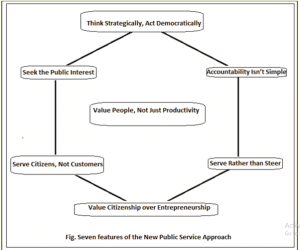APPROACH AND STRUCTURE
1. Write an introduction.
2. Write some basics about NPS.
3. Then compare it with TPA.
4. Then explain why it is an innovation.
5. Conclude
INTRODUCTION: The New Public Service(NPS) approach to public administration represents among the most influential post-NPM developments which tries to rebalance an restructure NPM by bringing in democratic philosophy.
BODY: The New Public Service approach to public administration was propounded by Denhardt and Denhardt in their popular work which came as critique to NPM model. Its overarching philosophy was Value over Productivity through its 7 features as follows:

Comparison between Traditional Public Administration and NPS:

How innovation?
TPA represents the administration from 1900s to 1960s when bureaucracy was the instrument to maintain status quo and law and order. TPA faced less challenges due to lack of alternatives for citizens to get services.
On the other hand, NPS came in the backdrop of NPA as well as NPM. It’s considered an innovation because it incorporates the theoretical roots:
- Democratic model of citizenship
- Community development model
- Social capital approach of Robert Putnam
- Post-modern models
The Traditional Public Administration (TPA) modeled on the Weberian bureaucracy had the functional and behavioral features which were oriented towards efficient implementation of governmental decisions. The TPA was insular, distancing and believed in the idea of bureaucratic rationality. It claimed that being an expertise institution having specialized knowledge it “knows the best”.
So, NPS is not similar to TPA though it has normative aspects propouned byTPA. NPS tries to make PA more democratic, voice-oriented, multisector-oriented and stakeholder-oriented. It has tools and techniques of NPM in order to increase 3Es but at the same time puts citizens at the centre stage of process of governance. In TPA, the centre stage was the administration-exercise of authority, law of domination but NPS is about putting citizens at the core, motive of serving people, valueing people rather than valueing rules, procedures and exercise of authority.
A pertinent example would be the changing profile of Development Administration in India. Earlier, the schemes and programmed conceptualized and implemented by the bureaucracy without actually knowing the ground reality and the need for the people. This has been one major reason for failure of the Community Development Programme and others. In contrast, today the NPS follows a more participatory, decentralized and demand-based approach. Thus, the overall delivery of services to public are optimized.

CONCLUSION: Due to its emphasis on broader aspects of democratic values and restructuring of NPM, it has characterized the nature of PA in post-NPM era so much so that MBC-III also included NPS in its theme under future of PA. Therefore, NPS has become a very relevant development in PA which has been taken as value dimension of PA under the emerging New Public Governance paradigm.
Spread the Word
